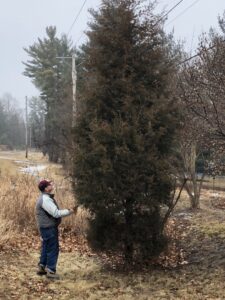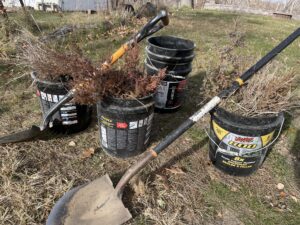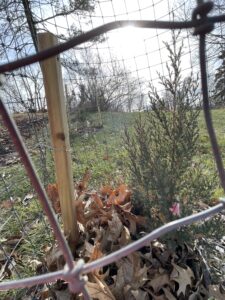On a windy cold Thanksgiving afternoon, we did something nutty. After tossing buckets and shovels into our pickup we drove north until we spotted greenish foliage popping through the road ditches dry grass.
There, we rescued six red cedar trees that are now at home in our yard.
A Hardy Tree
 Few American trees have such a love-hate relationship with people as the red cedar, which is actually a Juniper. Perhaps it’s unpopular because of the plant’s amazing adaptability. Sure, it needs full sunlight but given that it thrives in heat, salty roadsides, and terrible soil it is one hardy plant! Even stiff grass competition that snuffs out other baby trees doesn’t seem to bother it.
Few American trees have such a love-hate relationship with people as the red cedar, which is actually a Juniper. Perhaps it’s unpopular because of the plant’s amazing adaptability. Sure, it needs full sunlight but given that it thrives in heat, salty roadsides, and terrible soil it is one hardy plant! Even stiff grass competition that snuffs out other baby trees doesn’t seem to bother it.
Red cedars thrive from the Great Plains eastward to the Atlantic Ocean. In many places they are small bushes, but sometimes the tree grows big enough to interest loggers. The aromatic wood is used to craft cedar chests, closet linings, and even pencils. Fence posts made of it last for decades.
Why Ranchers and Farmers Dislike Cedars
Ranchers curse cedars because they spread in pastures. Cattle don’t like dining on prickly cedar twigs, and within a decade or two cedars replace the grassy food that cows love with a green desert of scrubby trees.
What’s to Love About Red Cedars
But, a cedar grove isn’t really a desert. Birds, especially cedar waxwings, love eating their tiny blue berries, and dense stands of cedars protect many species of wildlife from howling wind, searing sun, and predators.
There’s more. We live in Cedar Rapids, a city named for the rugged trees that grow in rocky bluffs over the Red Cedar River. They’re small and twisted but some are over 400 years old.
We planted our cedars on the edge of our property where they will form a screen from the wind and passing car headlights. They also will give us privacy, and be a safe home for birds that visit our feeders.
In mid-December, we’ll return to the road ditch and cut a six-foot red cedar for our Christmas tree. Cedars are scraggly and unsymmetrical, but we don’t put our tree up in the house. It will grace the Holiday season on our back deck. Pouring a few cups of sunflower seeds in its foliage creates a living stream of ornaments as goldfinches, chickadees, cardinals, and nuthatches come and go.
For information on red cedars and many other trees visit the website of the National Arbor Day Foundation.
- We rescued seedlings to plant for screens in our yard.
- We remember to protect the seedlings.




Cedar trees at Christmas brought me back to the 1960’s where the seniors at my K-9 school headed out into the fields around the school to chop down 6-7 footers to decorate for the winter concert. An undecorated cedar leaned upright in every corner of the school halls. The school sat in the former farm fields and woods of northern Virginia before the rampant development of the last half century. Its curriculum had an emphasis on nature so the day after the concert, the trees were dragged out to be recycled as shelter for animals along the trails through the wooded areas. Every student looked forward to the senior privilege of a wintry day out in those fields. And the property owners were pleased to have the larger cedars removed!
this is a fun memory! thank you.
You can tell if an area has limestone bedrock by the Red Cedars. In the glacial till with sandstone bedrock around my area there are few cedars. When you go south in Ohio you find plenty of cedars where there is limestone.
Very interesting, Gordon! thanks for this piece of geology and botany.
Well, the cedar grows here in Virginia across many pastures, roadsides and some in my yard. Indeed the birds love those trees for safety from raptors and the rabbit enjoys it as well. I even had one for a Christmas tree in a huge pot on the north facing porch one year and then transplanted it into the yard near the side door.
We plan to cut one when Nancy is here, put on the back deck and decorate with bird and squirrel treats.